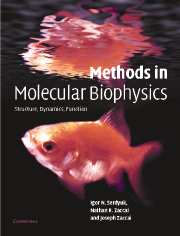Book contents
- Frontmatter
- Contents
- Foreword by D. M. Engelman
- Foreword by Pierre Joliot
- Preface
- Introduction: Molecular biophysics at the beginning of the twenty-first century: from ensemble measurements to single-molecule detection
- Part A Biological macromolecules and physical tools
- Part B Mass spectrometry
- Part C Thermodynamics
- Part D Hydrodynamics
- Part E Optical spectroscopy
- Part F Optical microscopy
- Part G X-ray and neutron diffraction
- Part H Electron diffraction
- Part I Molecular dynamics
- Part J Nuclear magnetic resonance
- Chapter J1 Frequencies and distances
- Chapter J2 Experimental techniques
- Chapter J3 Structure and dynamics studies
- References
- Index of eminent scientists
- Subject Index
- References
Chapter J1 - Frequencies and distances
from Part J - Nuclear magnetic resonance
Published online by Cambridge University Press: 05 November 2012
- Frontmatter
- Contents
- Foreword by D. M. Engelman
- Foreword by Pierre Joliot
- Preface
- Introduction: Molecular biophysics at the beginning of the twenty-first century: from ensemble measurements to single-molecule detection
- Part A Biological macromolecules and physical tools
- Part B Mass spectrometry
- Part C Thermodynamics
- Part D Hydrodynamics
- Part E Optical spectroscopy
- Part F Optical microscopy
- Part G X-ray and neutron diffraction
- Part H Electron diffraction
- Part I Molecular dynamics
- Part J Nuclear magnetic resonance
- Chapter J1 Frequencies and distances
- Chapter J2 Experimental techniques
- Chapter J3 Structure and dynamics studies
- References
- Index of eminent scientists
- Subject Index
- References
Summary
Historical review
1924
W. Pauli proposed the theoretical basis for NMR spectroscopy. He suggested that certain atomic nuclei have properties of spin and magnetic moment and, as a consequence, exposure to a magnetic field leads to splitting of their energy levels. W. Gerlach and O. Stern observed the splitting in atomic beam experiments, providing proof for the existence of nuclear magnetic moments.
1938
I. I. Rabi and colleagues first observed NMR by applying electromagnetic radiation in atomic beam experiments. Energy was absorbed at a sharply defined frequency, causing a small but measurable deflection of the beam. Rabi received the Nobel prize for physics in 1944.
1946
Research groups led by F. Bloch and E. M. Purcell reported the observation of proton NMR in liquid water and solid paraffin wax. Bloch and Purcell shared the 1953 Nobel prize for physics.
1946
F. Bloch suggested a new method of excitation using a short radio-frequency pulse and in 1949 E. L. Hahn showed that this did indeed produce a free precession signal. Hahn also established that pulse sequences could be used to generate additional information in the form of a spin echo. For many years, however, these methods were of little use to chemists because of the complexity of the signal obtained. In 1956, I. J. Lowe and R. E. Norberg pointed out that the time-domain signal and the frequency-domain spectrum are related by Fourier transformation. The first high-resolution multichannel Fourier transform NMR spectrum was measured by R. R. Ernst and W. A. Anderson.
Information
- Type
- Chapter
- Information
- Methods in Molecular BiophysicsStructure, Dynamics, Function, pp. 971 - 999Publisher: Cambridge University PressPrint publication year: 2007
